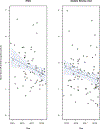Emergency Department Door-to-Puncture Time Since 2014
- PMID: 31182000
- PMCID: PMC8225226
- DOI: 10.1161/STROKEAHA.119.025106
Emergency Department Door-to-Puncture Time Since 2014
Abstract
Background and Purpose- The impact of a mobile stroke unit (MSU) on access to intraarterial thrombectomy (IAT) is a prespecified BEST-MSU substudy (Benefits of Stroke Treatment Delivered Using a Mobile Stroke Unit Compared to Standard Management by Emergency Medical Services). On the MSU, IAT decision-making steps, such as computed tomography, neurological exam, and tPA (tissue-type plasminogen activator) treatment are completed before emergency department arrival. We hypothesized that such pre-ED assessment of potential IAT patients on an MSU improves the time from ED arrival to skin puncture time (door-to-puncture-time, DTPT). Methods- BEST-MSU is a prospective comparative effectiveness study of MSU versus standard management by emergency medical services (EMS). We compared ED DTPT among the following groups of MSU and EMS patients: all IAT patients, IAT patients post-tPA, and IAT patients post-tPA meeting thrombolytic adjudication criteria over the first 4 years of the study. Results- From August 2014 to July 2018, a total of 161 patients underwent IAT. Ninety-four patients presented to the ED via the MSU and 67 by EMS. One hundred forty patients received tPA before IAT, 85 in the MSU arm, and 55 in the EMS arm. One hundred twenty-six patients received tPA within thrombolytic adjudication criteria: 76 MSU and 50 EMS. DTPT in minutes was shorter for MSU patients (all IAT MSU versus EMS 89 versus 99, P=0.01; IAT post-tPA MSU versus EMS 93 versus 100, P=0.03; and IAT post-tPA within adjudicated criteria MSU versus EMS 93 versus 99.5, P=0.03). From 2014 to 2018, DTPT decreased at a faster rate for EMS compared with MSU-managed patients, improving by about an hour. Conclusions- Pre-ED IAT evaluation on an MSU results in faster DTPT compared with arrival by EMS. Since 2014, dramatic improvement in ED IAT metrics has attenuated this difference. However, DTPT in all groups indicates substantial room for improvement.
Keywords: decision making; emergency department; emergency medical services; hospital; puncture; stroke; thrombectomy.
Figures
References
-
- Goyal M, Demchuk AM, Menon BK, et al. Randomized Assessment of Rapid Endovascular Treatment of Ischemic Stroke. N Engl J Med. 2015;372(11):1019–1030. - PubMed
-
- Berkhemer OA, Fransen PSS, Beumer LA, et al. A Randomized Trial of Intraarterial Treatment for Acute Ischemic stroke. N Engl J Med. 2015;372(1):11–20. - PubMed
-
- Campbell BC, Mitchell PJ, Kleinig TJ, et al. Endovascular therapy for ischemic stroke withperfusion-imaging selection. N Engl J Med. 2015;372(11):1009–1018. - PubMed
-
- Jovin TG, Chamorro A, Cobo E, et al. Thrombectomy within 8 hours after symptoms onset in ischemic stroke. N Engl J Med. 2015;372(24):2296–2306. - PubMed
-
- Saver JL, Goyal M, Diener HC, et al. Stent-retriever thrombectomy after intravenous t-PA vs t-PA alone in stroke. N Engl J Med. 2015;372(24):2285–2295. - PubMed
Publication types
MeSH terms
Substances
Grants and funding
LinkOut - more resources
Full Text Sources
Medical


